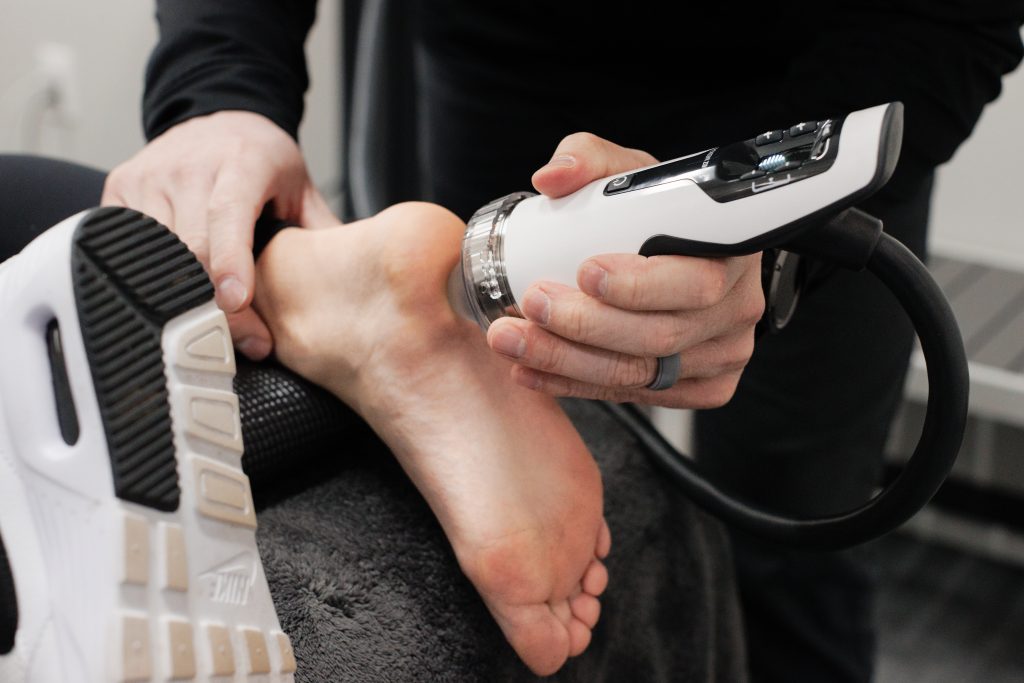Plantar fasciitis is one of the most common causes of heel pain, affecting millions of individuals annually. It occurs when the plantar fascia—a thick band of tissue connecting your heel to your toes—becomes inflamed, often due to overuse or strain. For those struggling with this condition, daily activities can become a painful challenge. Shockwave Therapy for Plantar Fasciitis
Focused Shockwave Therapy (SWT) has emerged as a groundbreaking treatment for plantar fasciitis, offering a non-invasive, evidence-based alternative to traditional options like injections, orthotics, or even surgery. In this post, we’ll explore how shockwave therapy works to alleviate plantar fasciitis pain and highlight the science supporting its effectiveness.
Understanding Plantar Fasciitis
The plantar fascia is a ligament that acts as a shock absorber, supporting the arch of your foot. Repeated stress or tension can cause tiny tears in the tissue, leading to inflammation, stiffness, and pain—especially in the morning or after periods of inactivity.
Traditional treatments often focus on reducing symptoms through rest, stretching, or pain medications, but these methods may not address the root cause: poor tissue healing. This is where focused shockwave therapy stands out.
What Is Focused Shockwave Therapy?
Focused shockwave therapy uses acoustic waves to target the damaged tissues in your foot. These waves are delivered at a precise frequency and depth, stimulating biological processes that promote tissue repair and reduce pain.
Key mechanisms of action include:
- Increased Blood Flow: Shockwaves improve microcirculation in the plantar fascia, enhancing oxygen and nutrient delivery to damaged tissue.
- Cellular Regeneration: The therapy stimulates the production of collagen, a crucial protein for repairing and strengthening ligaments.
- Pain Modulation: Shockwaves desensitize nerve endings in the treatment area, providing pain relief.
- Reduction of Inflammation: It triggers the release of anti-inflammatory molecules, accelerating the resolution of chronic inflammation.
- Breakdown of Calcifications: In some cases, plantar fasciitis involves the formation of calcium deposits. Shockwave therapy can help break down these deposits, restoring normal tissue function.

Research Supporting Shockwave Therapy for Plantar Fasciitis
A growing body of research highlights the effectiveness of shockwave therapy for treating plantar fasciitis:
- Meta-Analysis by Sun et al. (2017)
- A meta-analysis published in the Journal of Orthopaedic Surgery and Research reviewed multiple studies on shockwave therapy for plantar fasciitis. The researchers concluded that shockwave therapy significantly reduces pain and improves function compared to placebo or conservative treatments.
- Randomized Controlled Trial (Rasmussen et al., 2008)
- A study in the Journal of Bone and Joint Surgery compared shockwave therapy to sham treatments in 245 patients with chronic plantar fasciitis. The shockwave group showed a 60% improvement in pain scores after 12 weeks, far outperforming the placebo group.
- Long-Term Benefits (Gerdesmeyer et al., 2008)
- Research published in Foot & Ankle International found that the benefits of shockwave therapy are not only significant but also long-lasting, with many patients experiencing relief for up to a year after treatment.
- Comparative Studies
- Studies have shown that focused shockwave therapy is as effective—if not more—than corticosteroid injections but without the risks or side effects associated with invasive treatments.
What to Expect During Treatment
Shockwave therapy sessions for plantar fasciitis are straightforward:
- Initial Consultation: The first step is a thorough evaluation to confirm the diagnosis and ensure shockwave therapy is appropriate for your condition.
- Treatment Sessions: Each session lasts approximately 15–20 minutes. A specialized device delivers focused acoustic waves to the plantar fascia, targeting damaged tissue.
- Recovery: Shockwave therapy is non-invasive, meaning there’s no downtime. You may experience mild discomfort or soreness for 24–48 hours post-treatment, but this is a sign that the body’s healing response is activated.
- Frequency: Most patients require 3–5 sessions, spaced one week apart, to achieve optimal results.
Advantages of Shockwave Therapy for Plantar Fasciitis
- Non-Invasive: No needles, no surgery, and no lengthy recovery periods.
- Quick Results: Many patients report significant pain relief within weeks.
- Long-Term Relief: By promoting tissue healing, shockwave therapy addresses the underlying cause of plantar fasciitis, reducing the likelihood of recurrence.
- Minimal Side Effects: Unlike medications or injections, shockwave therapy has a low risk of adverse effects.
Conclusion
For those dealing with the persistent pain of plantar fasciitis, focused shockwave therapy offers a scientifically validated solution that promotes healing, reduces pain, and helps you return to an active lifestyle. Backed by robust research, this non-invasive therapy stands out as a safe and effective alternative to conventional treatments.
If plantar fasciitis is holding you back, schedule a consultation with our team at [Your Clinic Name] to see if shockwave therapy is right for you. Reclaim your mobility and take the first step toward a pain-free future today!
References:
- Sun, J., et al. (2017). Extracorporeal shockwave therapy in chronic plantar fasciitis: A meta-analysis. Journal of Orthopaedic Surgery and Research.
- Rasmussen, S., et al. (2008). Shockwave therapy for chronic plantar fasciitis. Journal of Bone and Joint Surgery.
- Gerdesmeyer, L., et al. (2008). Long-term effects of extracorporeal shockwave therapy. Foot & Ankle International.

Recent Comments